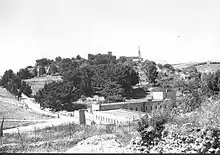Kiriath-Jearim
Kiriath-Jearim (also Kiryat Ye'arim) (Hebrew: קִרְיַת-יְעָרִים Qiryaṯ Yə‘ārîm; Ancient Greek: Καριαθιαριμ "city of woods", Latin: Cariathiarim) [1] was a city in the Land of Israel. It is mentioned 18 times in the Hebrew Bible. The biblical place was identified with Abu Gosh.

Etymology
Other names are Kiriath-Ba'al, Ba'alah and Ba'ale-Judah (see, e.g. Joshua 15:60; 2 Samuel 6:2; I Chronicles 13:6), which implies the city was affiliated with Baal worship at an earlier date.[2]
History
In Eusebius' Onomasticon, Kiryat Ye'arim is placed about 9 Roman miles, or about 15 km (9.3 mi), from Jerusalem. Palestine Exploration Fund explorers Conder and Henderson have identified it with the site now known as Khirbet 'Erma, a ruin located 3.6 kilometres (2.2 mi) south of Kesla and 6.4 kilometres (4.0 mi) east of Beit Shemesh.[3] However, starting with Edward Robinson, biblical Kiriath-Jearim has been more often identified with Deir el-Azar (Tel Qiryat Yearim),[4][5] a place near Abu Ghosh on a hill where the Deir El-Azar Monastery currently stands, about 7 miles west of Jerusalem. This site was the only major biblical site in ancient Judah that had not been excavated, until an excavation began in 2017 by a team from Tel Aviv University and the Collège de France.[6]
Kiriath-Jearim was described as a Hivite city linked to the Gibeonites (see Joshua 9:17). It was a key landmark in identifying the border between the tribes of Judah and Benjamin (see Joshua 15:9 & 18:14, 15). It is mentioned as the place the Ark of the Covenant may have been moved after being in Beth Shemesh (1 Samuel 6:21-7:2). About 60 years (2 Sam 6) afterward, the ark was moved to Jerusalem and placed in a tent outside the palace of David.
Kiriath-Jearim's change in designation from Kiriath-Ba'al betrays the population change that took place after Joshua's military campaign to take possession of the land from its previous inhabitants. The religious basis for the war is revealed in the city's renaming; the name Baal belonged to a pagan deity and, according to the Bible, the God of Israel ordered Joshua and the Israelites to erase the memory of the Ba'al cult (see Joshua 18.14). However, the name change does not reflect the Yahwist religious affiliation of the city's conquerors; rather, it reflects salient geographical features.
The Scriptures identify at least one prophet of God who came from this town. Uriah, the son of Shemaiah, was from Kiriath-Jearim, and was a contemporary of Jeremiah who prophesied against Jerusalem (see Jeremiah 26:20). This aroused the wrath of King Jehoiakim (r. 609-598 BC) who sought to put Uriah to death. Uriah escaped to Egypt, where he was apprehended by the king's henchman and extradited to Jerusalem for execution and burial in an unmarked grave (Jeremiah 26:22-23).
The writer of Chronicles teaches that Shobal (possibly a descendant of Caleb) was "the father of Kiriath-Jearim" (see 1 Chronicles 2:50-53), possibly in the sense of being the founder of this town.
Descendants of Kiriath-Jearim were among the Jewish exiles who returned to Judea with Zerubbabel (see Nehemiah 7:29).
References
- The spelling Kiryat Yearim may be found, for example, in Silberman and Finkelstein's (2001) The Bible Unearthed, page 125.
- "Temporary Home of The Ark of The Covenant". Biblical Archaeology Review. July/August 2017, Vol. 43, No. 4: 12.
- Conder, C. R., The Survey of Western Palestine, Memoirs, III, pp. 43–ff.
- Cooke, Francis T. (1925). "The Site of Kirjath-Jearim". Annual of the American Schools of Oriental Research. New Haven: Yale University Press. 5 (1923–1924): 105.
- Robinson, E. (1856). Later Biblical Researches in Palestine and in the Adjacent Regions - A Journal of Travels in the Year 1852. Boston: Crocker & Brewster. p. 156.
- "The Shmunis Family Foundation Excavations at Kiriath-Jearim". The Shmunis Family Foundation Excavations at Kiriath-Jearim. Retrieved 2019-12-29.
